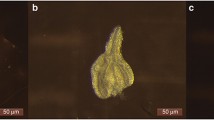Abstract
Background
The adriamycin mouse model is a well-established teratogenic model of esophageal atresia/tracheoesophageal fistula. Fibroblast growth factor 10 (Fgf10) plays a key role in branching of the lung buds during lung morphogenesis. Fgf10 knockout mice exhibit the absence of the lungs. Optical projection tomography (OPT) is a technique that allows three-dimensional (3D) imaging of gene expression in small tissue specimens in an anatomical context. The aim of this study was to investigate the temporo-spatial expression of Fgf10 during the critical period of separation of the trachea and esophagus in normal and adriamycin-treated embryos using OPT.
Methods
Time-mated CBA/Ca mice received intraperitoneal injections of adriamycin (6 mg/kg) or saline on days 7 and 8 of gestation. Embryos were harvested on days 10–13, stained after whole mount in situ hybridization with labeled RNA probes to detect Fgf10 transcripts (n = 5 for each treatment/day of gestation). Immunolocalization with endoderm marker Hnf3β was used to visualize morphology. Embryos were scanned by OPT to obtain 3D representations of gene expression domains.
Results
Computer reconstructed specimens allowed precise staging of developing embryos according to Theiler Staging (TS) criteria. OPT elegantly displayed Fgf10 gene expression in the pulmonary mesenchyme around the tip of the lung buds in both controls and treated embryos in the same spatial territory. Fgf10 gene expression was first detected in the control embryos at TS17. However, Fgf10 gene expression in adriamycin-treated embryos was first only observed at TS18 in 67% of the specimens.
Conclusion
Delayed Fgf10 gene expression during the critical period of separation of the trachea and esophagus may affect lung bud formation in the adriamycin model leading to tracheoesophageal malformations.



Similar content being viewed by others
References
Diez-Pardo JA, Baoquan Q, Navarro C, Tovar JA (1996) A new rodent experimental model of esophageal atresia and tracheoesophageal fistula: preliminary report. J Pediatr Surg 31:498–502
Dawrant MJ, Giles S, Bannigan J, Puri P (2007) Adriamycin produces a reproducible teratogenic model of vertebral, anal, cardiovascular, tracheal, esophageal, renal and limb anomalies in the mouse. J Pediatr Surg 42:1652–1658
Ioannides AS, Chaudhry B, Henderson DJ et al (2002) Dorsoventral patterning in oesophageal atresia with tracheo-oesophageal fistula: evidence from a new mouse model. J Pediatr Surg 37:185–191
Dawrant MJ, Giles S, Bannigan J, Puri P (2007) Abnormal separation of the respiratory primordium in the adriamycin mouse model of tracheoesophageal malformations. J Pediatr Surg 42:375–380
Merei JM, Hasthorpe S, Farmer P, Hutson J (1998) Relationship between esophageal atresia with tracheoesophageal fistula and vertebral anomalies in mammalian embryos. J Pediatr Surg 33:58–63
Bellusci S, Grindley J, Emoto H, Itoh N, Hogan BLM (1997) Fibroblast growth factor 10 (Fgf10) and branching morphogenesis in the embryonic mouse lung. Development 124:4867–4878
Min H, Danilenko DM, Scully SA, Bolon B, Ring BD, Tarpley JE, DeRose M, Simonet WS (1998) Fgf-10 is required for both limb and lung development and exhibits striking functional similarity to Drosophila branchless. Genes Dev 12:3156–3161
Ramasamy SK, Mailleux AA, Guptea VV, Mata F, Sala FG, Veltmaat JM, Del Moral PM, De Langhe S, Parsa S, Kelly LK, Kelly R, Shia W, Keshet E, Minoo P, Warburton D, Bellusci S (2007) Fgf10 dosage is critical for the amplification of epithelial cell progenitors and for the formation of multiple mesenchymal lineages during lung development. Dev Biol 307:237–247
Sekine K, Ohuchi H, Fujiwara M, Yamasaki M, Yoshizawa T, Sato T, Yagishita T, Matsui D, Koga Y, Itoh N, Kato S (1999) Fgf10 is essential for limb and lung formation. Nat Genet 21:138–141
Ang SL, Wierda A, Wong D, Stevens KA, Cascio S, Rossant J, Zaret KS (1993) The formation and maintenance of the definitive endoderm lineage in the mouse: involvement of HNF3/forkhead proteins. Development 119:1301–1315
Ang SL, Rossant J (1994) HNF-3 beta is essential for node and notochord formation in mouse development. Cell 78:561–574
Sharpe J, Ahlgren U, Perry P, Hill B, Ross A, Hecksher-Sorensen J, Baldock R, Davidson D (2002) Optical projection tomography as a tool for 3D microscopy and gene expression studies. Science 296:541–545
Summerhurst K, Stark M, Sharpe J, Davidson D, Murphy P (2008) 3D representation of Wnt and Frizzled gene expression patterns in the mouse embryo at embryonic day 11.5 (Ts19). Gene Expr Patterns 8(5):331–348
Theiler K (1972) The house mouse. Springer, Berlin
Brown E, James K (2009) The lung primordium an outpouching from the foregut! Evidence-based dogma or myth? J Pediatr Surg 44:607–615
Maeda Y, Dave V, Whitsett JA (2007) Transcriptional control of lung morphogenesis. Physiol Rev 87:219–244
Metzger RJ, Klein OD, Martin GR, Krasnow MA (2008) The branching programme of mouse lung development. Nature 453:745–750
Costa RH, Kalinichenko VV, Lim L (2001) Transcription factors in mouse lung development and function. Am J Physiol Lung Cell Mol Physiol 280:L823–L838
Szebenyi G, Fallon JF (1999) Fibroblast growth factors as multifunctional signaling factors. Int Rev Cytol 185:45–106
Chuang PT, McMahon AP (2003) Branching morphogenesis of the lung: new molecular insights into an old problem. Trends Cell Biol 13:86–91
Abler LL, Mansour SL, Sun X (2009) Conditional gene inactivation reveals roles for Fgf10 and Fgfr2 in establishing a normal pattern of epithelial branching in the mouse lung. Dev Dyn 238:201–1999
Haynes T, Gutierrez C, Aycinena JC, Tsonis PA, Del Rio-Tsonis K (2007) BMP signaling mediates stem/progenitor cell-induced retina regeneration. Proc Natl Acad Sci USA 104:20380–20385
Li Y, Gordon J, Manley NR, Litingtung Y, Chiang C (2008) Bmp4 is required for tracheal formation: a novel mouse model for tracheal agenesis. Dev Biol 322:145–155
Author information
Authors and Affiliations
Corresponding author
Rights and permissions
About this article
Cite this article
Hajduk, P., Murphy, P. & Puri, P. Fgf10 gene expression is delayed in the embryonic lung mesenchyme in the adriamycin mouse model. Pediatr Surg Int 26, 23–27 (2010). https://doi.org/10.1007/s00383-009-2519-3
Published:
Issue Date:
DOI: https://doi.org/10.1007/s00383-009-2519-3




